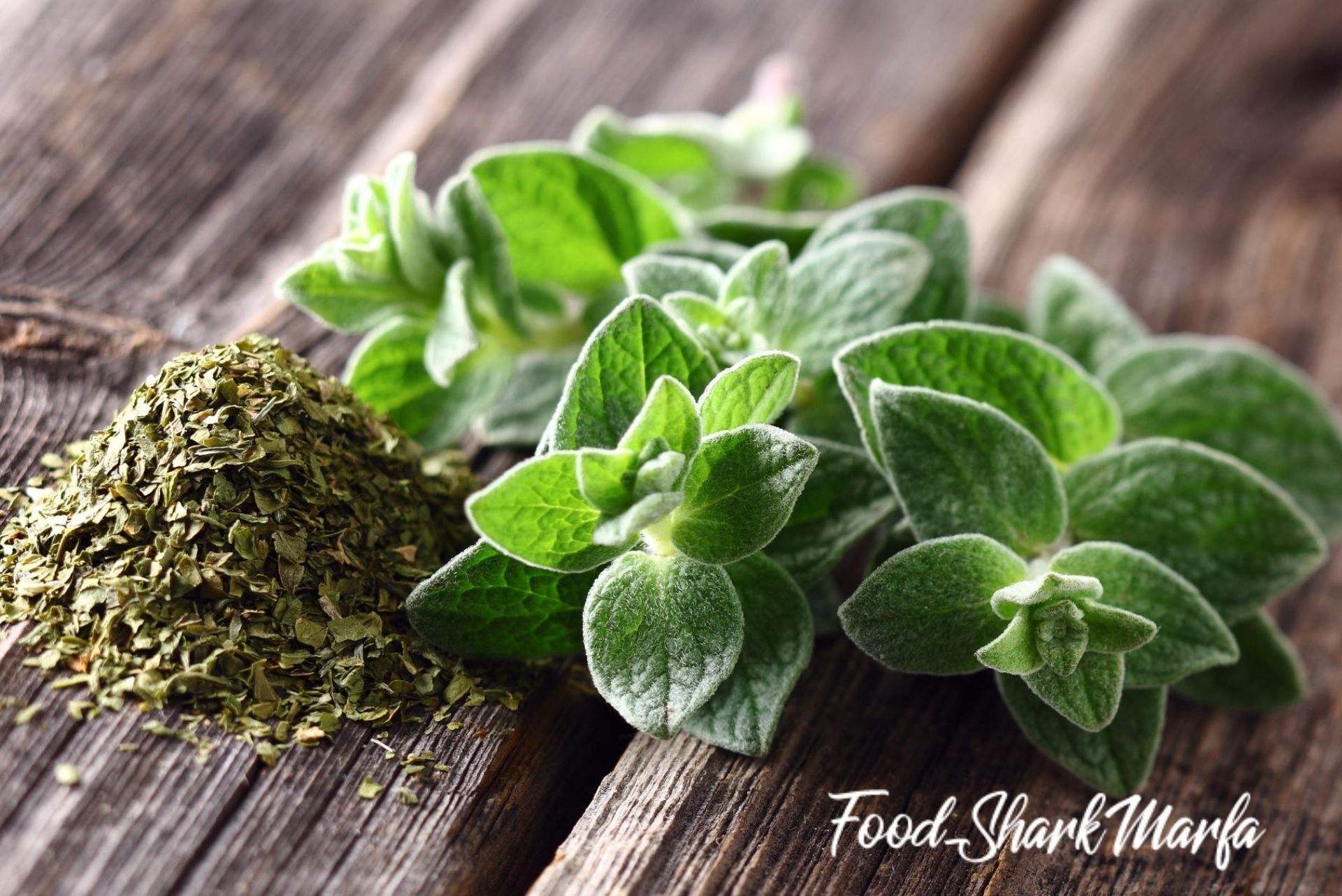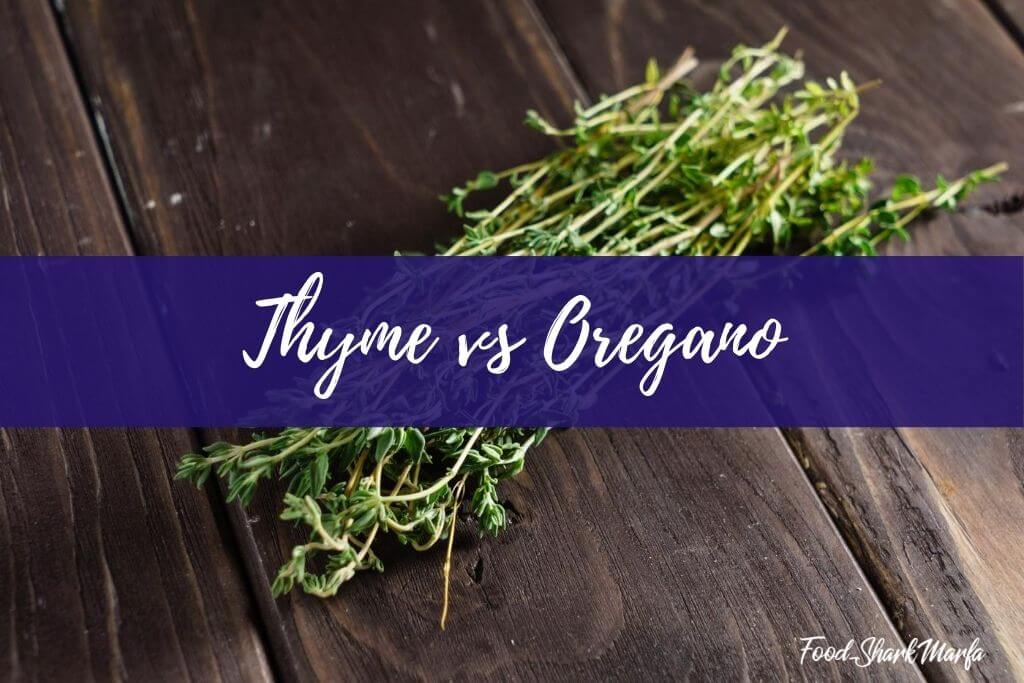In the thyme vs oregano debate, both originated in Mediterranean regions and are important herbs in Mediterranean recipes and other cuisines. Thyme and oregano are also both members of the same Lamiaceae plant family and pair well with many other herbs and some spices.
Thyme and oregano also have similar flavors with notes of lemon, mint and earthy hints and in some recipes may be substituted for each other. However, oregano has a much more assertive flavor than thyme which means it may overpower other flavors if too much is used.
If you are unsure as to just what is the difference between these two popular herbs, or how you should use them in cooking, read on to learn more about thyme vs oregano.
What Is Thyme and How Is It Used in Cooking?
There are different types of thyme (Thymus vulgaris) which all belong to the Lamiaceae or mint family. Thyme generally has a lemony and bright flavor with hints of mint, cloves and earthiness, although the flavor can vary depending on the type of thyme used.
Pronounced as ‘time’; thyme is a woody and low growing plant originating in the Mediterranean and like many herbs, it is an ancient herb used both by the Romans and the Ancient Egyptians.

Although thyme can be used alone, it is at its best when paired with other herbs, not least oregano, sage, marjoram, tarragon, rosemary or bay. It also suits being with garlic. In fact, thyme is a key component in bouquet garni, the blend of French herbs used in many stews, soups and broths.
Thyme is also used in Middle Eastern cooking where it flavors meats and is often found in flatbreads. In some European countries, goats and sheep are grazed on thyme for the flavor that it gives the meat.
As well as being ideal with lighter meats, thyme can also be used in wheat and rice dishes, most vegetables, root vegetables such as carrots and potatoes, tomatoes, shellfish and baked fish dishes . It can be used in salads and even fruit dishes and is an essential in various Creole recipes, not least jambalaya.

What Is the Difference Between Different Types of Thyme?
There are various types of thyme used in cooking, but French thyme, German thyme and English/common thyme are the most popular. Although all three of these are Thymus vulgaris, there are some differences between them.
English thyme (also known as common thyme) and German thyme have similar flavors, although German thyme contains more aromatic oils and English thyme has a more intense flavor.
English thyme has larger leaves and spreads more across the ground, while the German thyme has smaller leaves and grows more upright. German thyme is also hardier and will grow through winter.
French thyme, the essential ingredient in herbs de Provence has a similar flavor to common thyme but with sweeter hints. Its leaves are pointed, and the stems have hints of red. French thyme is a slow growing thyme and can be damaged by cold weather although French thyme will keep more of its flavor when dried compared to other thymes.
Generally, if a recipe does not specify which type of thyme, then common thyme is fine, unless a French recipe, in which case French thyme should be used if available. Otherwise, those with a more discerning palate may notice the difference in taste.
How to Use Fresh or Dried Thyme
Often easy to grow in the garden or even in a window box, thyme can be bought fresh or dried. Dried thyme has more flavor than fresh thyme, so always use less dried thyme in place of fresh.
Fresh thyme can either be used as whole stalks - which you will need to remove during or after cooking - or as leaves. To strip leaves from the stalk, hold the end of the stalk between your finger and thumb and use the fingers of your other hand to firmly move down the stalk, pulling the leaves off at the same time. Fresh thyme is often added as whole leaves, or they may need to be finely chopped with a knife.
If you want to keep fresh thyme for later, you can make some thyme ice cubes. To do this, strip the leaves off the stalks, wash them and place them into an ice cube tray. Rather than use your regular tray, you may want to invest in a dedicated silicone ice cube tray for freezing herbs, otherwise the aroma of the herbs may taint your drinks at a later date!
Once you have placed the thyme in, top up the ice cube compartment with water. Then, when you want to use thyme, just pop an ice cube or two into your recipe – don’t forget to reduce the liquid content of the recipe slightly to make up for the extra water in the ice cube.
You can also dry your own fresh thyme. The most traditional way to dry any herb is by hanging. Using fresh thyme stems before they have flowered, just wash them, leave them on paper towel to dry and then string the stalks together and hang them up somewhere which has a temperature of at least 50°F and low humidity.
If you place a paper bag gently over the hanging stalks, it will help keep the dust off and catch any leaves that fall off. In a couple of weeks or so, you can then strip the leaves off into a jar or other airtight container.

You can also just strip the thyme leaves from the stalk after they have been washed and allowed to air dry and then lay them out flat on a cookie sheet for a few days before transferring to an airtight container. If you have a dehydrator you can also strip the leaves from the stalk and dry them that way.
How Is Oregano Used in Cooking?
If you are a pizza lover, then you will be familiar with the assertive flavor of oregano. You will also come across oregano in a classic Greek salad. More pungently flavored and noticeable than thyme, oregano has lemon and floral flavors along with some earthiness. In fact, oregano is like a stronger version of marjoram with hints of pepper which come through in tomato-based recipes.

Like thyme, oregano is at its best when used with garlic and herbs such as thyme, parsley, basil, bay and marjoram, making it popular in various Mediterranean cuisines, not least, Italian, Spanish, Greek and more rustic French recipes. It is also used in Mexican cooking where it pairs well with cumin and cilantro.
As it is more pungent, oregano is best with meats such as beef, lamb or pork.
There are various perennial herbs classified as oregano. Originating in the Mediterranean, oregano (Origanum vulgare) is a bushy plant that grows up to around 2ft in height with flat and large leaves which may sometimes be fuzzy. The leaves also have a distinctive scent of hay with mint notes.

The name oregano is Greek and means ‘joy/delight of the mountains’ and it was first used by the Ancient Greeks for food and in medicines. Generally, where the oregano is grown affects its flavor – as in the hotter the environment, the stronger its flavor. The oregano available in stores is often Greek (or Mediterranean) and this type of oregano is also called wild marjoram. Greek oregano is earthier, Turkish is more pungent and Italian oregano is mild.
Depending on the time of year you may also be able to find stronger Mexican oregano, which comes into its own in chilies, salsas and other Latin American dishes.

Dried oregano can be one of these types or may be a mix of oreganos from different growing countries – you would need to check packaging to confirm.
Tips for Making the Most of Fresh and Dried Oregano
The fresh oregano leaves can be used as salad greens or in the way that you would use cilantro or fresh basil. When oregano is used fresh, its flavor does not transfer to other ingredients in the same way it would if you were using dried oregano in a pasta sauce. You can also lightly toast fresh oregano leaves in the pan and add them to tacos or chili.
Because oregano is one of the more pungent herbs, it does dry well and hold its flavor, so dried oregano should be used carefully to ensure you do not completely overpower other flavors in the dish. If the recipe asks for fresh oregano and you cannot find any, then use around a third of the amount of dried oregano in place of the fresh.
Like thyme, you can also freeze fresh oregano leaves in an ice cube tray or dry the leaves out either by hanging the stalks, or by just removing the leaves and drying out on a cookie sheet. Once the oregano is completely dry, place it in an airtight container away from any heat or light sources. It should keep its flavor for around six months or so.
If you decide to dry oregano on its stalks, you can pop some stalks in your smoker once dried to add extra flavor to your meat.
Can I Use Thyme in Place of Oregano?
Thyme and oregano do contain similar flavor notes and go well with similar dishes, however, many recipes, such as meat or tomato dishes, do ask you to add both. If the recipe only asks for one of the two, then depending on the recipe, you may be able to switch them out with little taste difference, although English/common thyme and French thyme have the best flavor to use in place of oregano.
If you have run out of thyme, then as well as a little oregano, some marjoram or even savory can take its place, or at a pinch, a little poultry or Italian seasoning. Avoid using rosemary to substitute thyme or oregano as its strong flavor may cause problems.
In Conclusion
In this post, I have looked in detail at thyme vs oregano. Although both thyme and oregano are Mediterranean herbs with flavors of mint, lemon and earthiness that can be used fresh or dried, oregano is the more pungent of the two.
Thyme is used in Middle Eastern and other cuisines while oregano often features in Latin American dishes where it goes well with cumin and cilantro. Both thyme and oregano are used in a wide range of European dishes and indeed, are often found in the same recipe.
They can sometimes be swapped for each other depending on the recipe, although common thyme and French thyme have the nearest flavor to oregano. Be careful when using oregano though as it is more pungent than thyme so can easily overpower some of the other flavors in the dish.


